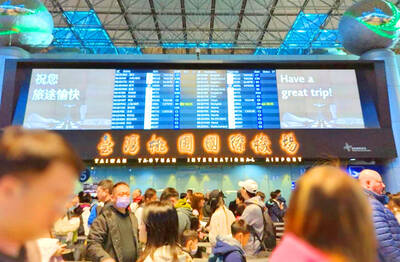Frustrated by seeing Taiwan’s culinary scene often reduced to simplistic perceptions, food journalist Clarissa Wei (魏貝珊) has decided to do something about it, writing a book titled Made in Taiwan that takes an incredibly deep dive into the nation’s cuisine.
Wei bristles at the idea of Taiwanese food being described simply as an extension of Chinese cuisine, or reduced to bubble tea and night market food, arguing in the book that waves of immigration, diplomatic isolation and a Taiwanese identity movement have given shape to an extremely diverse and unique food culture in the nation.
“I just don’t think the stories [of Taiwanese cuisine] have been told very well for the international audience,” Wei told the Central News Agency when asked what motivated her to write her book — at its core a cookbook that tells a far broader story than just recipes.

Photo courtesy of Clarissa Wei via CNA
Indeed, the conversation surrounding Taiwan has been long filtered either through politics or through talking points that Taiwanese officials peddle around the world, Wei said.
“The Tourism Administration only pushes night markets and bubble tea, but there’s so much more to our country than that,” Wei said.
Summarizing Taiwanese cuisine concisely can be elusive after evolving over centuries, but as Wei shows in her book, it is that very history which defines it.
She has matched various recipes to the historical periods in which they emerged, illustrating how Taiwanese food reflects a blend of the food culture of Taiwan’s Indigenous peoples and various colonial influences.
Those influences go back to the Dutch in the 16th century and the arrival of Koxinga, also known as Cheng Cheng-kung (鄭成功), from China, credited with the invention of the oyster omelet, Wei said.
Then there were Han Chinese who arrived during the Qing Dynasty, credited with braised minced pork belly, the Japanese during the era of colonization, who created Taiwanese tempura, and the Chinese who came after World War II and the Chinese Civil War, who brought beef noodle soup and soup dumplings.
It also reflects American influence that came when the US supported Taiwan during the Cold War, resulting in turkey rice and fried chicken cutlets, Wei wrote.
As Taiwan began to embrace democracy in the 1980s, a new type of open-air beer restaurant, referred to as “stir-fried restaurants,” emerged.
These establishments offered affordable lagers paired with speedy dishes that seamlessly melded regional Chinese elements, Japanese seasonings and locally sourced seafood — a fusion entirely distinctive to Taiwan, she said.
To showcase this diversity, Wei and her all-Taiwanese team traveled the nation and interviewed people from all walks of life, aiming to capture the full spectrum of what Taiwan has to offer.
“We interviewed a war veteran who came during the Chinese Civil War. He gave us his scallion pancake recipe,” Wei said.
“We also spoke with a grandmother who shared her sesame oil chicken soup recipe and a young rapper who is the third-generation owner of ‘Lin Family Braised Pork Over Rice’ in Tainan,” she said
Translating these recipes for an English-speaking audience, especially readers in the US, posed a major challenge due to important differences even in basic ingredients, Wei said.
Even something as standard as Taiwanese wheat flour posed issues, because while most of Taiwan’s wheat flour is imported from the US, the milling process differs.
Figuring it out and nailing down the texture was so satisfying for Wei, because these recipes could not be found in English and mastering the nuances was even difficult in Chinese.
As insistent as Wei is that Taiwanese food is more than just Chinese-influenced dishes or night market treats such as oyster omelets, her book fully acknowledges they are parts of a bigger picture.
Her book’s 11 chapters with recipes ranging from “Breakfast” and “Family Style” to “Beer Food,” “Night Market” and “Basics & Sauces” takes the reader on a culinary journey that spans rice noodle soup and popcorn chicken to the railway lunchbox.
There are even soup dumplings, though they were not invented in Taiwan.
Wei explains that the soup dumpling is from Shanghai and the surrounding province of Jiangsu, but they are included “because it was Din Tai Fung, a soup dumpling powerhouse headquartered in Taipei, that introduced the dish to the world.”
Each chapter and many of the recipes are accompanied by a story that connects readers to the cultural significance of the dishes, underpinning Wei’s main theme that Taiwan has a unique identity and food culture.
That driving force that runs throughout Wei’s work and is summarized by a quote by late Taiwanese democracy advocate Peng Ming-min (彭明敏) in the book’s opening pages: “[Neither] race, language nor culture form a nation, but rather a deeply felt sense of community and shared destiny.”

Foreign travelers entering Taiwan on a short layover via Taiwan Taoyuan International Airport are receiving NT$600 gift vouchers from yesterday, the Tourism Administration said, adding that it hopes the incentive would boost tourism consumption at the airport. The program, which allows travelers holding non-Taiwan passports who enter the country during a layover of up to 24 hours to claim a voucher, aims to promote attractions at the airport, the agency said in a statement on Friday. To participate, travelers must sign up on the campaign Web site, the agency said. They can then present their passport and boarding pass for their connecting international

Temperatures in northern Taiwan are forecast to reach as high as 30°C today, as an ongoing northeasterly seasonal wind system weakens, the Central Weather Administration (CWA) said. CWA forecaster Tseng Chao-cheng (曾昭誠) said yesterday that with the seasonal wind system weakening, warmer easterly winds would boost the temperature today. Daytime temperatures in northern Taiwan and Yilan County are expected to range from 28°C to 30°C today, up about 3°C from yesterday, Tseng said. According to the CWA, temperature highs in central and southern Taiwan could stay stable. However, the weather is expected to turn cooler starting tonight as the northeasterly wind system strengthens again

COOLING OFF: Temperatures are expected to fall to lows of about 20°C on Sunday and possibly 18°C to 19°C next week, following a wave of northeasterly winds on Friday The Central Weather Administration (CWA) on Sunday forecast more rain and cooler temperatures for northern Taiwan this week, with the mercury dropping to lows of 18°C, as another wave of northeasterly winds sweeps across the country. The current northeasterly winds would continue to affect Taiwan through today, with precipitation peaking today, bringing increased rainfall to windward areas, CWA forecaster Liu Pei-teng (劉沛滕) said. The weather system would weaken slightly tomorrow before another, stronger wave arrives on Friday, lasting into next week, Liu said. From yesterday to today, northern Taiwan can expect cool, wet weather, with lows of 22°C to 23°C in most areas,

Taiwan sweltered through its hottest October on record, the Central Weather Administration (CWA) said yesterday, the latest in a string of global temperature records. The main island endured its highest average temperature since 1950, CWA forecaster Liu Pei-teng said. Temperatures the world over have soared in recent years as human-induced climate change contributes to ever more erratic weather patterns. Taiwan’s average temperature was 27.381°C as of Thursday, Liu said. Liu said the average could slip 0.1°C by the end of yesterday, but it would still be higher than the previous record of 27.009°C in 2016. "The temperature only started lowering around Oct. 18 or 19